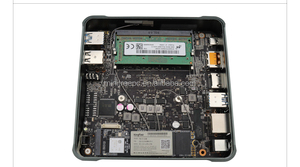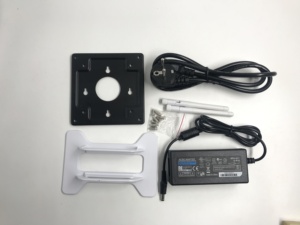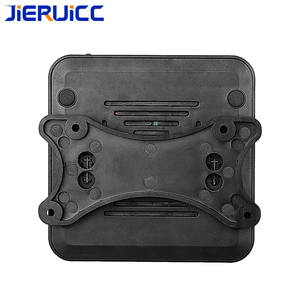(1003 products available)















































































































































































































A thin client with monitor is a computer device sold as a bundle or separately that consists of a computer monitor and a thin client. The thin client is a lightweight computer that depends on a server for its computational resources. The computer monitor, on the other hand, is a display screen for the thin client. Here are the various types of thin client with monitors.
The all in one thin client with monitor is a compact and integrated computer system that combines a computer monitor with a thin client. The two systems are built into the same device. This eliminates the need for a separate computer monitor and takes up minimal space on the desk. The all in one thin client with monitor has a neater and more organized appearance than separate thin clients and computer monitors.
The separate thin client and monitor are a thin client and computer monitor sold as separate entities rather than a bundle. The two systems are not integrated. As a result, the thin client and computer monitor are two separate and distinct devices. Buyers can choose a specific computer monitor and thin client according to their requirements and needs when buying them separately. They can also upgrade or change one system without impacting the other.
The mini thin client with monitor is a computer monitor and thin client in a relatively small and compact form factor. This makes it easy and convenient to use in places with limited space, such as a home office or a small business. Despite its size, the mini thin client with monitor offers various features and functions available in larger thin clients and computer monitors.
The industrial thin client with monitor is purposely built for use in industrial and commercial settings. It is robust, durable, and can withstand harsh environmental conditions like extreme temperatures, dust, and humidity. The thin client with monitor is designed to operate for long hours without fail, making it suitable for demanding industrial environments.
The gaming thin client with monitor is purposely built for gamers. It offers high performance and speed for gaming applications. The monitor has a high refresh rate and resolution for an optimal gaming experience. Also, the thin client has a powerful graphics processing unit (GPU) for rendering game graphics efficiently.
Thin clients have numerous applications that vary from offices, schools, and hospitals, among others. Some of the key applications of a thin client with monitor include the following:
Businesses that are interested in buying a thin client computer with a monitor for their staff members need to be strategic when selecting this product. The following are some key points to consider:
It is important to determine what the company requires, as this will help in identifying the best thin client solution that offers the necessary features and capabilities.
It is important to consider the number of people who will need the thin client computer and monitor. This will guide the buyer on how many monitors and client computers to order.
What kind of work will the users be doing on the thin client computer? This is an important question to consider because it will help in selecting a thin client computer that has the necessary software and hardware for the user's job.
Think about the monitor size that will best suit the user's work. Designers, engineers, and other professionals who need to see detailed graphics may require a larger monitor. However, typical office tasks can be done on a standard-sized monitor.
Select a monitor with a resolution that fits the work. Professionals who work on detailed graphics will need a higher resolution, while those handling standard office tasks can use a standard resolution.
Consider the connectivity options that the thin client and its monitor offer. Ensure they match the user's needs. For example, professionals who need to connect to several devices will require a monitor with multiple ports.
It is important to select thin client computers and monitors that use energy efficiently. This will help reduce energy costs and lower the company's carbon footprint.
Consider thin client computers and monitors with security features such as firewalls and antivirus software. This will help protect the company's data and prevent unauthorized access to the system.
Choose thin client computers and monitors that come with a warranty and good after-sales support. This will ensure that any issues with the product are resolved quickly.
Q1: What kind of monitor is needed for a thin client?
A1: Thin clients are compatible with virtually any kind of monitor, but the type needed depends on the thin client's connectivity options.
Q2: Can thin clients be used with existing monitors?
A2: Yes, thin clients can be used with existing monitors, as long as they are compatible with the connectivity options offered by the thin client or can be adapted to work together.
Q3: How to choose a monitor for a thin client?
A3: When choosing a monitor for a thin client, consider the display size, resolution, connectivity options, panel type, and additional features such as ergonomic adjustments and built-in speakers.
Q4: Does a thin client need a special monitor?
A4: A thin client does not need a special monitor. It can work with any standard monitor available. The monitor specifications for the thin client are similar to those of personal computers. This means it can work with a monitor that has a VGA, HDMI, or DVI connector. The monitor may have a larger screen or better resolution, but this is not mandatory. A thin client performs the same functions as a personal computer. It can access the internet and run office applications. It does not have special requirements when it comes to the monitor.
Q5: Can a thin client work with more than one monitor?
A5: In most cases, a thin client can work with more than one monitor. However, this depends on the thin client model. One will need to check the thin client specifications to see if it can work with more than one monitor. Some thin clients have one video output. It means it can only work with one monitor. Others have two or more video outputs and can work with two or more monitors. One can connect the monitors through the available ports. Working with more than one monitor increases productivity and makes multitasking easier. One can extend the display to the extra monitors or duplicate the display. Duplicate display allows the same content to appear on both monitors. Extending the display allows different content to appear on each monitor. It is important to note that using more than one monitor may affect the performance. Multi-tasking is possible, but the thin client may lag or be slow. This is because it has to work with several monitors at the same time.